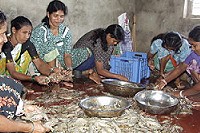 Definition:
Definition:
The cultivation of freshwater or marine organisms, such as fish, shrimps, oysters or algae is called aquaculture or sometimes also aqua-farming. Most species are not domesticated and need seeds from the wild, but part of their life cycle is controlled.
The official FAO definition of aquaculture for statistical purposes can be found here.
Some facts:
-
Aquaculture is an ancient activity that developed near settled population centres. The best documented records accessible so far are from China, but various forms of husbandry of fish and other animals living in the water can be deduced from historical records, such as in India, ancient Egypt and during the period of the Roman empire. A history of aquaculture focused on Asia is available on the website of FAO.
-
China and India are the foremost modern-day producers (and consumers) of farmed Chinese and Indian carps and other aquatic organisms.
-
Modern aquaculture is a fast-growing activity with annual production increases estimated at between 4 and 8% in the last 2 decades. Almost 40% of the fish and seafood we eat today is from aquaculture.
-
An estimated 73.8 million tons of fish and other aquatic organisms (but not counting marine plants) were produced through some form of farming or husbandry in 2014 (up from 51.7 million in 2006). 47.1 million tons were from freshwaters, 26.7 million tons from marine waters. China accounts for approximately 60% of global aquaculture production.(1).
-
The largest quantities of cultured species are low in the food web, such as Indian carps, Nile tilapias, filter-feeding bivalves and marine algae, however, the cultivation of more expensive carnivorous species has increased massively over the years.
-
Parts of aquaculture are controversial, particularly the following:
-
cultivation of carnivorous species, because the reduce the overall food availability – 2-5 kg of feed fish is required to produce one kg of the carnivorous, high value species – most of the feed (fish and fish oils) could be consumed directly by humans;
-
destruction of large swathes of coastal mangroves and wetlands for the construction of coastal ponds for the culture of shrimps and other high-value species, often destroying more sustainable livelihoods in the process;
-
intensive cultivation in net cages has been shown to spread disease and parasites to their wild relatives (Pacific salmon in Canada);
-
the introduction of alien species can lead to involuntary escapees and establishment of exotic populations at the expense of native species;
-
use of antibiotics and medicinal feeds, high energy demand and water pollution;
- social conflicts between private appropriation of land and water vs harvesting the commons and other livelihood strategies.
-
-
Some of the criticised practices have been improved as a result of public pressure and research or are in the process of being improved. Moreover, the rediscovery of old concepts of integrated resource use and their exploration in contemporary contexts of competition for space, water, energy, skilled labour and other resources encourages constant innovation and many improvements.
-
Forms of aquaculture integrated with other resource use has been shown to increase overall productivity of land, water and living organisms. Put simply, this is because it mimics recycling of resources similar to what happens in natural ecosystems, where the 'waste' of one process is an input into another. Examples are
-
integrating pond aquaculture with growing fruit trees and/or vegetables on dykes as is common practice in South and South-east Asia. Some such systems in peri-urban areas also use night soil as a source of fertilisation. The PAPUSSA project (Production in aquatic peri-urban systems in southeast Asia) was an international science cooperation (INCO) project in the 5th European Research Framework Programme investigating such integrated systems.
-
Sanggou Bay and Huangdun Bay in China. Sanggou is a rural area, while Huangdun is near an industrial zone. In both regions, integrated forms of marine farming combine shellfish culture, fish in net cages and seaweeds. The idea was to turn a liability (e.g. agricultural run-off or domestic waste waters that could otherwise provoke eutrophication problems and dead zones without oxygen) into an asset (provided there are no toxic substances which are released and could accumulate in the food web). The SPEAR project (Sustainable options for people, catchment and natural resources) brought together an international scientific consortium to study and compare the two exploitation systems in order to provide management advice and help them to become sustainable. The project was an international science cooperation (INCO) project in the 6th European Research Framework Programme). The SPEAR book summarising results and is available here.
-
Summaries of more examples can be seen in the catalogue of synopses of International S&T Cooperation (INCO) projects on challenges in fisheries, coastal zones, wetlands and aquaculture.
-
- A new index is being developed to assess aquaculture performance by country or by species against ecological standards or other policy objectives. The index is called 'Global Aquaculture Performance Index (GAPI). Monitor developments here.
(1) FAO, 2016. The State of World Fisheries and Aquaculture, 2016. Rome, Food and Agriculture Organization of the United Nations, 200 p. Click here for the report.








